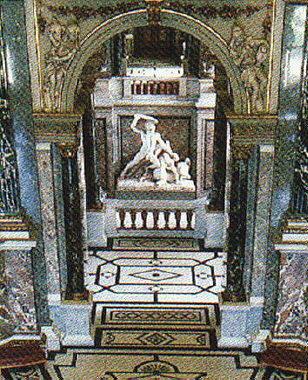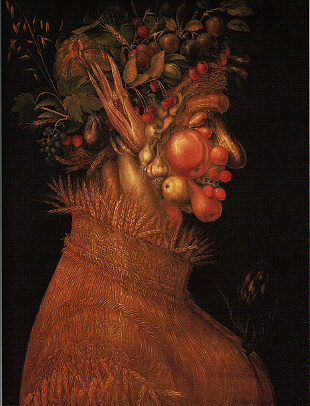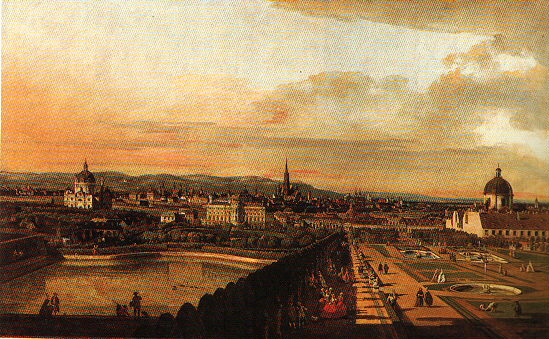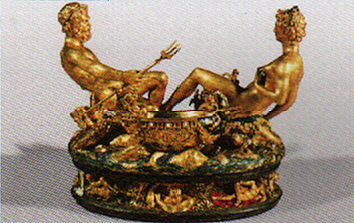
The Museum of Fine Art in Vienna
 |
If the parole in the Museum of Natural History is "to learn", in the Museum of Fine Art it is "to feel". Naturally the Gallery of Paintings is the heart of the museum, but already on the staircase to the second floor, Antonio Canova's group of Theseus captures my attention. Neither can I deny myself to be impressed by the architecture and the ornamentation of the building itself. You could easily spend a whole day here, studying only that part...
|
 |
The Gallery of Paintings consists in its left part of German, Flemish und Dutch art, in the right wing there are Italian, French and Spanish masters to be seen. Even if my personal favourites are to be found among the latter group, I can't help being touched by the art of Dürer, Cranach or Holbein, or to smile at Archimboldo's imagination, which made him paint his famous heads, consisting only of attributes to one special theme. Thus the Head of Fire is based only on candles, lamps, burning wood, etc., whereas the Head of Summer is shown by ripe ears of grain, a cucumbernose and fruits.
Of course there is Pieter Bruegel the Elder to be mentioned, of whom the Museum of Fine Art owns the world's largest collection. But there are also well-nourished ladies by Rubens, or pieces by Frans Hals, van Eyck, Vermeer and Rembrandt.
|
 |
In the other half of the gallery there are paintings by Lotto, Veronese, Tintoretto, Titian and Raphael, in front of which time comes to a standstill.
Corregio's mythological narratives about Jupiter's love-affairs gain of course in content, if you are familiar with the background-story. The affectionate Io, for example, might possibly have had another thought, had she known that she was to spend a large part of her life as a cow, because of this divine adventure...
The dramatic effects of light in Caravaggio's paintings, as in "David with the head of Goliath", make a deep impression. The nose of Cagnacci's Cleopatra may have been slightly adjusted, but her suicide by being bitten of poisonous snakes is touching anyhow. This painting is widely spread through a stamp.
Diego Velazquez' court paintings mustn't be forgotten, in his time they served as photo-exchanges of our dearest do today. And also the work of Seisenegger, the painting of Emperor Charles V, in whose empire the sun never set, has historical value.
|
It is of course totally impossible to mention all the names, which are exhibited here; Reni, Tiepolo, Ricci and Batoni may be representatives for the 18th century, as is Bernardo Belloto, also called Canaletto, who through his views of Vienna at about 1760 has forwarded a tiny bit of history.

Descending the staircase again, I come to think of how much more this visit in the Gallery of Paintings meant. It were not only the paintings, that talked to me, but through their content it became an experience in social history, mythology, religion and history of the world.
A half staircase down there is a department for the collections from the Ancient World. I am sorry to see, that it is closed because of renovation. It says that there are artefacts to be seen from the early Ancient World until the Great Migration.
The collections from ancient Egypt on the same floor are closed because of the same reason. There are findings from prehistoric times until the Roman Empire. Today those collections can be seen again, but instead the Kunstkammer is restored until 2004, where there are shown collections of Sculpture and Decorative Arts. Anyhow, the Kunstkammer was still open at the time of my visit, so I went there, to see at least some more of the treasures, that are kept here.
 And I am not disappointed. The collections start at the Middle Ages until the Baroque and show a multitude of objects, which once again would need much more time than a little more than one hour, which is the amount that I have got before closing time.
And I am not disappointed. The collections start at the Middle Ages until the Baroque and show a multitude of objects, which once again would need much more time than a little more than one hour, which is the amount that I have got before closing time.
There is a special department for watches and automatons, which surely delights every connoisseur; there are busts and statues in wood, stone and bronze, curiosities as saltcellars, board games and table decorations, utility goods as a communion chalice or Maria Theresia's golden breakfast set; there are bottles, glasses and cups of all kinds and origin, as there are gems in wide variations.
Actually I had had in mind to have a look at the Coin Cabinet on the third floor, where there are shown means of payment from the first coins, made by King Kroisos in Lydia, until todays Euro. But the afternoon has past already, so I just don't have the time needed.
There are other collections, belonging to the Museum of Fine Art, as the Ephesus-Museum,
the Museum of Carriages, the Treasury and a Collection of Ancient Musical Instruments, which altogether are shown at other places, due to lack of space.
Reaching the exit and looking across the Maria-Theresia-Square, I once again come to think of the comparison with videos... Using the 7 Euros I paid for the ticket, I had been able to rent up to three videos. It would have taken the same amount of time to watch them - but how much more exciting wasn't the experience of this afternoon!
Back to  or to the or to the  of of 
19.3.2002 by webmaster@werbeka.com
|





 And I am not disappointed. The collections start at the Middle Ages until the Baroque and show a multitude of objects, which once again would need much more time than a little more than one hour, which is the amount that I have got before closing time.
And I am not disappointed. The collections start at the Middle Ages until the Baroque and show a multitude of objects, which once again would need much more time than a little more than one hour, which is the amount that I have got before closing time.
